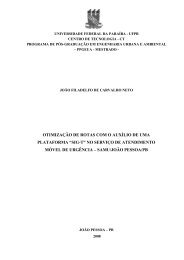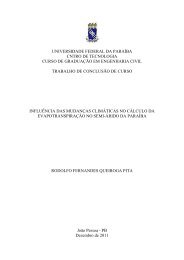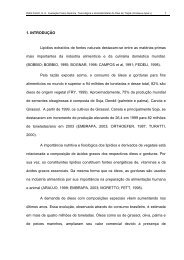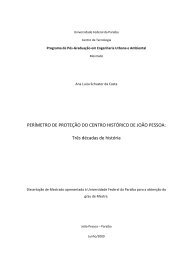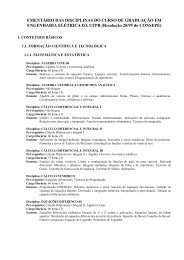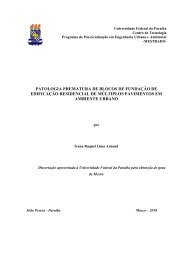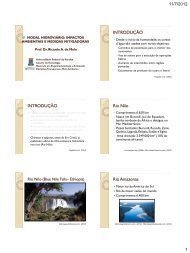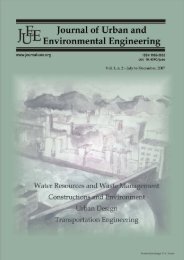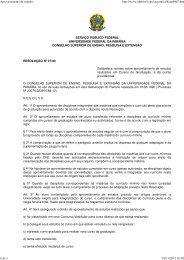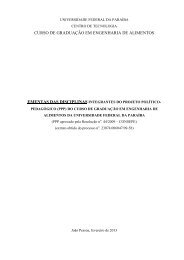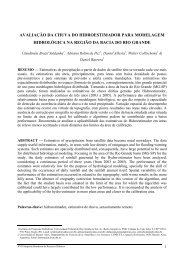editorial team
editorial team
editorial team
You also want an ePaper? Increase the reach of your titles
YUMPU automatically turns print PDFs into web optimized ePapers that Google loves.
Martínez and Poleto<br />
2<br />
INTRODUCTION<br />
Most South American cities present accelerated growth<br />
trends; however, they are disorganized, generating<br />
negative impacts especially on bodies of water (Poleto<br />
et al,. 2009a; Deletic et al,. 1997), principally due to the<br />
increase of impermeable surfaces like roadways, roofs,<br />
parking lots, among other things, which reduce the rate<br />
of infiltration and increase surface runoff, thus<br />
increasing transport of urban sediment and pollutant<br />
loads to watercourses (Poleto et al., 2009b; Taylor<br />
2007; Charlesworth et al., 2003; Deletic et al., 1997).<br />
Urban drainage networks are responsible for conveying<br />
these loads and it is now known that they constitute<br />
important sources of degradation of rivers, lakes and<br />
estuaries Horowitz (2009), (Deletic et al., 1997).<br />
Sediments in urban areas are submitted to man-made<br />
alterations from different sources, as for example, the<br />
input of organic matter coming from discarding sewage<br />
in a clandestine manner, in the same way as particles of<br />
human origin present in large quantities in urban<br />
environments, such as glass particles, metallic particles,<br />
residues from industrial processes and civil<br />
construction, which present chemical and mineralogical<br />
properties different from sediment particles from natural<br />
sources, which results in these sediments interacting in a<br />
different way within the environment (Poleto &<br />
Martínez, 2009); Taylor (2007). Sediments deposited in<br />
roadways have become, through time, an important<br />
means for determining the human contribution of<br />
pollutants, especially that of heavy metals. The<br />
ubiquitous nature of road deposited sediments, their<br />
ease of sampling, their strong association with<br />
automobile emissions, and their relationship with<br />
nonpoint source pollution make them a valuable archive<br />
of environmental information (Sutherland 2003).<br />
More precisely, one of the chemical characteristics<br />
of vital importance in the study of urban sediments is<br />
adsorption of heavy metals. Banerjee (2003) defines the<br />
behavior of heavy metals in terms of the most common<br />
different solid phases found in urban sediments in Table 1.<br />
Affinity of heavy metals by sediments is strongly<br />
influenced by particle size (Deletic et al., 1997;<br />
Charlesworth et al., 2003; Sutherland, 2003; Taylor,<br />
2007; Poleto et al., 2009a). There is sufficient evidence<br />
that shows the fact that sediments are enriched with<br />
heavy metals, above all in the fine particle fraction. In a<br />
similar way to sediments in other environments,<br />
increase in the pollutant load in finer sized particles is<br />
generally associated with the increase of surface area in<br />
smaller sized particles, providing greater space for<br />
adsorption of metals in clay minerals or in organic<br />
matter present in sediment particles. Understanding that<br />
heavy metal loads are heterogeneously distributed is<br />
important in the formulation of pollution management<br />
and control strategies (Horowitz, 2009; Poleto et al.,<br />
2009b; Taylor, 2007). Fergusson & Ryan (1984) studied<br />
Table 1. Affinity of heavy metals in sediments<br />
Solid phase fraction<br />
Exchangeable<br />
Carbonate<br />
Fe-Mn oxide bonding<br />
Organic matter<br />
Residual<br />
Adapted from: Banerjee (2003).<br />
Affinity of heavy metal<br />
Cd > Pb > N i> Zn > Cu > Cr<br />
Cd > Zn > Pb > Ni > Cu > Cr<br />
Zn > Pb > Ni = Cu > Cd > Cr<br />
Cu > Pb > Zn > Ni > Cd > Cr<br />
Cr > Ni > Cu > Cd > Pb > Zn<br />
the composition of particles deposited in urban areas,<br />
specifically particle size and the sediment source; they<br />
found that many of the elements analyzed increased<br />
with reduction in particle size, a result corroborated by<br />
Al-Rajhi et al. (1996).<br />
In urban environments, heavy metals are part of our<br />
daily activities and many of them enter in the urban<br />
environment as subproducts of economic activities<br />
which are considered typical in urbanizing watersheds<br />
(Poleto & Charlesworth, 2010; Poleto et al., 2009a;<br />
Poleto & Martínez 2009; Irvine et al., 2009); in the case<br />
of lead, it frequently appears as a subproduct from<br />
petroleum and coal combustion; tire, oil, paint and<br />
welded part residues (Horowitz, 2009; Poleto & Merten,<br />
2008; Charlesworth & Lees 1999). Lead concentration<br />
values are variable and depend in large part on<br />
surrounding local conditions; Sutherland (2003) found<br />
that 51% (221 µg.g -1 ) of the lead load present in<br />
sediments deposited in urban roadways in Hawaii were<br />
found in the < 63 µm fraction; Robertson et al. (2003)<br />
found concentrations of 354 µg.g -1 within the city of<br />
Manchester (United Kingdom); Charlesworth et al.<br />
(2003) found average values of 48 and 47.1 µg.g -1 in the<br />
cities of Birmigham and Coventry (United Kingdom),<br />
respectively; Irvine et al. (2009) reported values of 276<br />
µg.g -1 in the city of Hamilton, Ontario (Canada); an<br />
average value of 230.52 µg.g -1 with a maximum of 3060<br />
µg.g -1 were found by Yongming et al. (2006) in the<br />
province of Xi’an in China; McAlister et al. (2005)<br />
reported concentrations from 200 to 700 µg.g -1 in areas<br />
with diverse soil uses in the city of Rio de Janeiro<br />
(Brazil) and Poleto et al. (2009) found concentrations<br />
from 16 to 110 µg.g -1 in 20 cities in the South of Brazil.<br />
Sediments deposited in roadways are commonly<br />
associated with risks to the environment and to<br />
human health, mainly in children (Taylor, 2007;<br />
Charlesworth et al., 2003; Al-Rajhi et al., 1996).<br />
Environmental and health effects initially depend on<br />
the mobility and availability of the elements, and the<br />
mobility and availability in terms of their chemical<br />
speciation and fractionation within or on particles<br />
(Banerjee, 2003). In the case of lead, there is<br />
evidence that indicates that exposure to this metal<br />
(inhalation or through consumption of contaminated<br />
foods) can trigger problems in the central nervous<br />
system, as well as having carcinogenic effects (Wang<br />
et al., 2005).<br />
Journal of Urban and Environmental Engineering (JUEE), v.4, n.1, p.1-8, 2010



